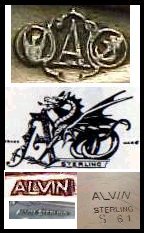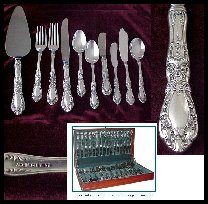ABOUT STERLING
& ABOUT THIS PATTERN:
STERLING SILVER FLATWARE was developed
in the 1400s in England and formal dining had evolved into a high art by
the 17th century. Royalty used full sets of flatware in the 1600s, and European
aristocrats quickly followed suit. More silverware was manufactured in Britain
during the Victorian period than ever before or after. It was during
the 19th century that the middle classes first reveled in their new-found
wealth and the British Empire was at its height. Hosts and hostesses entertained
with elaborate sets of fine sterling, effectively albeit discretely making
a statement regarding their wealth and social position. American manufacturers
were quick to recognize a positive trend and flatware manufacturing soared
in the mid-1800s when vast silver reserves were discovered in Nevada mines.
From the mine to the table, it takes more than 30 steps to turn pure silver
into a sterling silver dining utensil.
MANUFACTURER: The
Alvin Silver Manufacturing Company was founded during the latter
part of the 19th century. Their original headquarters in 1886 was located
in New Jersey. Historical records reference multiple names for this manufacturer,
including The Alvin Silver Manufacturing Company, The Alvin Mfg Co., Alvin
Silver Co., and The Alvin Corporation.
Alvin was known
for manufacturing not only its fine sterling silver flatware, but
also for its hollowware (i.e. - tea sets, bowls, etc), and
toiletware (i.e. - exquisitely detailed sterling handmirrors, etc.)
The various makers marks displayed at right appeared on Alvin sterling
items from the 1800's through the middle of the 20th century. The
oldest marks are positioned towards the top of the image.
In 1895 The Alvin Silver Manufacturing Company relocated from New
Jersey to Sag Harbor, New York where it began manufacturing popular
silverware based on historical patterns.
|
 |
SILVER MANUFACTURING COMPETITORS:
The Gorham Mfg. Co. of Providence, Rhode Island, Tiffany & Co., Alvin
Manufacturing Co., and Black, Starr & Frost. all of New York, Reed
and Barton of Taunton, MA, the Bailey, Banks & Biddle Co., J.E. Caldwell
& Co., Simons Bros. Co. of Philadelphia, PA, as well as Shreve & Co. of
San Francisco, CA. and Lebolt Company of Chicago, IL.
Alvin's profitable Colonial reproductions brought it in direct competition
with the prominent Gorham Company of Providence, Rhode Island.
Gorham prudently negotiated the purchase of Alvin’s dies in 1928. Alvin
now functions as a division of Gorham which still produces some of the
early Alvin patterns.
|
STERLING PATTERN:
This vintage sterling pattern, which
is no longer manufactured, is entitled Prince Eugene
and it was so named in honor of the famed Prince Eugene of
Savoy. |
Prince Eugene of Savoy (1663–1736).
General, politician and diplomat.
| In the year 1683 Prince
Eugene of Savoy came to Vienna, Austria, as an impoverished twenty-year-old
nobleman burdened with debts. He was a French prince of Italian
descent, who subsequently earned a reputation as one of the greatest
military commanders in modern history. Over the course of his career
he amassed considerable wealth, and by the end of his life was considered
one of the richest men in Europe. Prince Eugene strengthened Austria's
position as a great power, was known as a patron of the arts, and
built the magnificent Belvedere palaces, considered a triumph of
Baroque splendour. Prince Eugene is lauded in Austrian songs as
"the noble Knight". |
|


